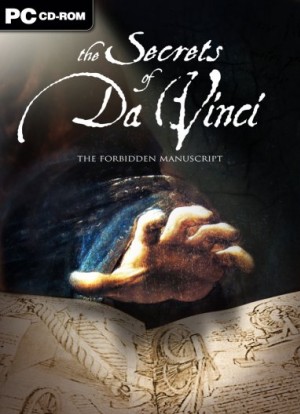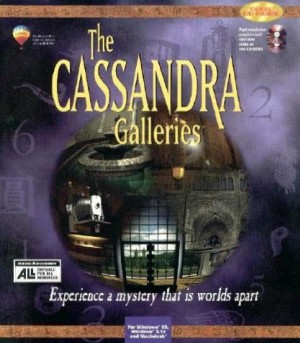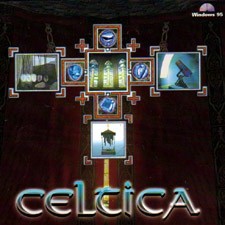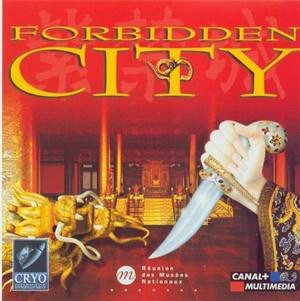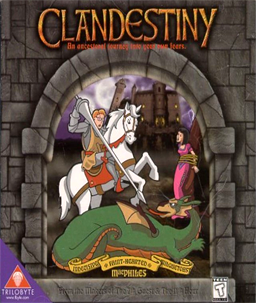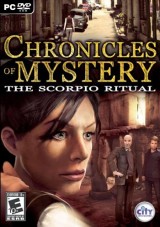Review for The Secrets of Da Vinci: The Forbidden Manuscript
Never trust outward looks. Or first impressions. Do not trust second impressions either, for that matter. Things can be deceiving, and not always by chance. So when you see a game called The Secrets of Da Vinci: The Forbidden Manuscript, do not assume that it is adapted from Dan Brown's bestselling novel – it isn't. Do not assume that it's nothing more than a rip-off, trying to ride the franchise's popularity at the time of the movie's release – it isn't either. And do not think that because the title refers to a "forbidden manuscript", the game involves dark and forbidden secrets – it doesn't. Oh, wait a minute; does this mean the second impression might not have been completely unfounded after all? Indeed not, but only as far as the title is concerned. Is your head spinning already? Good! You're getting in the right frame of mind for the intrigue the game offers.
The year is 1522, three years after Leonardo da Vinci, arguably the greatest mind of the western world, died in France. The story begins as a young Italian artist named Valdo arrives at Cloux manor, the master's final residence, next to the city of Amboise where king François I holds his court. Valdo has been hired to discover a mysterious codex that Leonardo is rumoured to have hidden on the estate before his death. Dissimulations abound: Valdo has been told to keep his mission secret, claiming instead to have come to study Leonardo's machines and to look for one of his old sketches, while his employer only contacts him through letters which he never signs. The manor's current inhabitant, Marie de la Bourdaisière, known as Babou to her friends, is too beautiful and clever to be completely trustworthy, and even the estate's caretaker probably knows more than he is letting on. But the master dissimulator is definitely Leonardo himself, who has carefully hidden the clues leading to the manuscript.
The Secrets of Da Vinci was co-designed by Kheops Studio and Totm Studio, who collaborated previously on ECHO: Secrets of the Lost Cavern, and the Kheops touch is clear from the first. Trying out a new Kheops game is pretty much like doing a physical, going over the same important things with the same general characteristics -- ("The point and click interface? Still functional! And the obligatory gunpowder-making sequence? Hasn't aged one bit!") -- with one notable difference: things keep improving over time. Another frequent Kheops collaborator, Mzone, the graphics studio that takes delight in disproving reviewers who proclaim first-person node-based games too antiquated, delivers a superb rendition of the manor and its park. The museum now in charge of the estate was actually involved in the design of the game, to ensure historically accurate depictions. Fully animated cinematics are well done but unfortunately rather scarce, often replaced by drawings. The music tries to capture the mood of the time, and is eminently hummable; a sometimes faulty implementation, however, makes cues unpleasantly overlap from time to time.
But, of course, the feature every Kheops fan is waiting for is the inventory. Well, it is still there, tabs and all, and still necessary as Valdo collects quite an impressive collection of items, from a signet ring to freshly-cut logs, in his seemingly bottomless pockets. But the system has undergone three major improvements over Kheops' previous games. First, items are automatically put in your inventory when you pick them up, instead of piling together in a waiting zone. The game even tries to be clever; for instance, if you use a handle on a machine and then get it back, it will be put back where you had originally stored it. The system doesn't always work, and items sometimes end up in an unexpected slot, but it is still a convenient feature. Second, you can't combine items in your inventory any more. This does not mean that it is no longer possible to combine things, but it must now be done in the proper place – for instance, on the table where Leonardo kept his chemical apparatus if you want to brew something. You never have to go looking for illogical or hard to find locations, as was the case in ECHO; it always makes complete sense, and contributes to making the puzzles more realistic. The third improvement deals with the way more than one of the same item is handled. Instead of imposing the same arbitrary limit for all items, the game lets you pick up as many as is needed for a "standard" playthrough, so most of the time you won't have to go back to where the item was to get more, while not overcrowding your inventory with things you'll never use. Still, being heavily non-linear and featuring optional puzzles and alternate solutions, the game can't always predict exactly what you may need, but it works well enough for that never to feel cumbersome.
The reason this works is that puzzles never get repetitive. With such a system, your inventory would have been overfilling with clay in Return to Mysterious Island or plants in VOYAGE. Not so with The Secrets of Da Vinci. The game does not rely on making you do the same thing over and over again, maintaining a constant freshness throughout. The puzzles are varied, often focusing on getting Leonardo's machines to work (after understanding what their purpose is), solving riddles, preparing various chemicals and useful items, as well as some puzzles solved through interactive sketches. Many of them can be solved at any time during the span of the game (one night and three days), and some can be left unsolved, or be solved more easily by buying items from the caretaker – at a cost to both your finances and self-esteem, of course. But you will have to solve the vast majority of the puzzles to complete the game. I prefer it this way, as it means that, while remaining free to decide when and how you solve things, you will not finish the game with the frustrating feeling of having left most of the puzzles untouched. As usual with Kheops' games, a score system keeps track of your successes – but again it doesn't fully do its job of encouraging replays, since no maximum score is offered as a goal to attain.
With so many games, even today, feeling gratuitously frustrating, The Secrets of Da Vinci deserves praise for having puzzles that always make sense and for never relying on dirty tricks or obtuse logic to artificially increase its length. But the challenges can be rather easy, partly because of the simple elegance of Leonardo's inventions, and partly because the game tends to hint a bit too hard in the right direction, whether in conversations, in the description of items, or in Valdo's diary (where he also keeps track of the tasks at hand). Still, first and foremost, they are fun; they contribute to shaping the game into a big treasure hunt, devoted to exploring and figuring things out; simple pleasures which lie at the heart of adventuring. Oh wait, never trust the first or second impression, remember? So there is an exception to the fun puzzles near the end of the game: a painting task which, for some reason, plays out as some sort of slider puzzle. If you've played ECHO, your complexion is probably turning as green as Mona Lisa's – and rightly so, for this puzzle was also featured in that game. It was tedious, frustrating and out of place the first time around, and it is tedious, frustrating and out of place this time too. Thankfully, the game "features" no less than two distinct bugs that allow you to solve it more easily than intended, or even to skip it altogether; so if a patch ever gets released for that game, think long and hard before applying it.
Apart from this regrettable blemish, The Secrets of Da Vinci clearly follows the successful Kheops formula, with some welcome tweaks – which already paves the way for a very solid game. But wait, there's more! The real surprise is that it actually has a plot. The mystery surrounding the codex is not an excuse for churning out puzzles, but the premise of a real story that remains strong throughout, accelerating as the game progresses and the masks start falling – only to reveal more masks underneath. The limited cast of characters probably constitute the most interesting mystery, and the game's solid writing drives the player to discover more about them. Leonardo, who appears at various times in flashbacks, is especially well handled. Without ever making him rise from his desk, the designers managed to give him an impressive aura that does justice to such a unique mind. Unfortunately, as is the case with most of the other characters, the voice acting is rather uninspired, when not downright horrendous. It seems like both the actors and whoever translated the game from the original French version handled each of the lines individually, with no idea of their context, giving rise to nonsensical replies and out-of-place deliveries. While not compromising the enjoyability of the game, the lack of professionalism that permeates the English version clearly fails to do it justice.
The game also tries to give the player some control over the plot by offering choices at various points. This is especially embodied by the good/evil system: depending on the actions you choose, a gauge in the inventory will move more towards good or evil. For instance, if you try to put a sleeping potion into Babou's drink, in hopes of getting her out of the way to search her rooms, your evil ranking will rise; on the other hand, if you are honest with her about the real nature of your mission, it will move toward good. If you remain consistently good or bad throughout the game, Valdo will start refusing to perform certain actions that would be against his nature (such as stealing if he has been consistently good). It is also possible to use some of the points you earn for solving puzzles to adjust your good/evil ranking, if you want to experiment with the story.
Still, it must be made clear that the plot is not the main focus of the game. By the time it seems like it is about to evolve into a complicated conspiracy story, it has already started to move towards its conclusion – and to be perfectly honest, I still have to pause for a moment to remember what the game's titular manuscript was all about. The plot is fine as it is, but I feel that it would have been even better had it been allowed more space to breathe, with more locations to explore, more characters to meet, more secrets to uncover – in short, if the game had been longer. And while the choices and good/evil system are a welcome and extremely promising addition, The Secrets of Da Vinci is definitely not The Pandora Directive, or even Indigo Prophecy. As a matter of fact, you really have to be relentlessly following your moral path to see it influence the story and for options to start being taken away from you. The game's ending follows the same pattern: your choices, including some made pretty early on, lead to four endings; but just blink for a moment and you will fail to notice the rather slight differences between them.
Deceiving outward looks, masks under masks... As you start playing The Secrets of Da Vinci, it is tempting to see it as an ambitious narrative endeavour; but it is eventually revealed not to have strayed too far away from the usual Kheops mould: a sweet but unassuming game for a niche genre. Still, with its clever, elegant puzzles and a light-hearted plot loaded with twists, it is definitely the most enjoyable game I have played in a long time. And, while not fully used, the new narrative devices go in a very interesting direction. At the rate Kheops and their partners keep improving from game to game, I have no doubt a real masterpiece is just around the corner – and that is not just a first impression.


